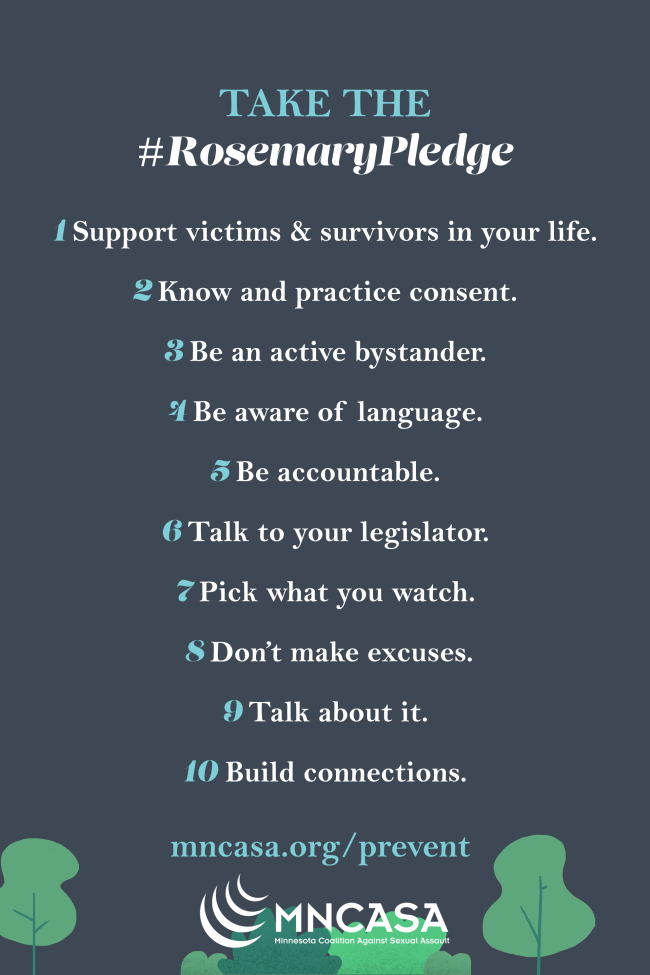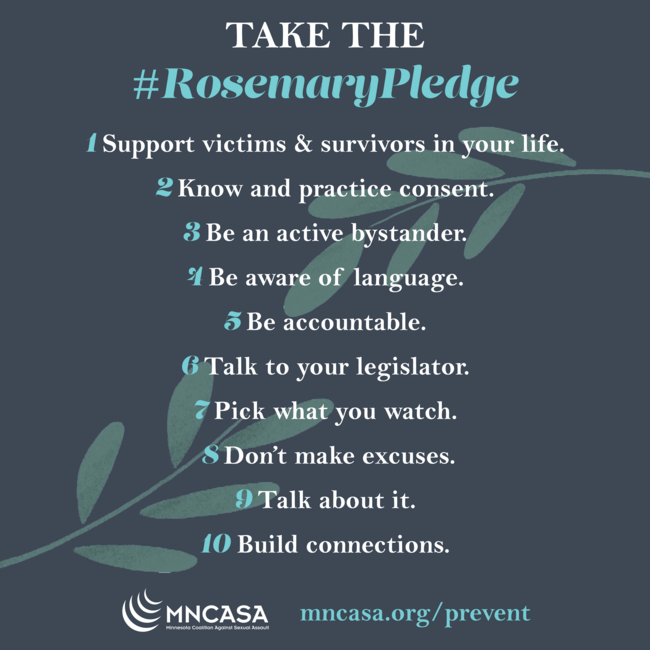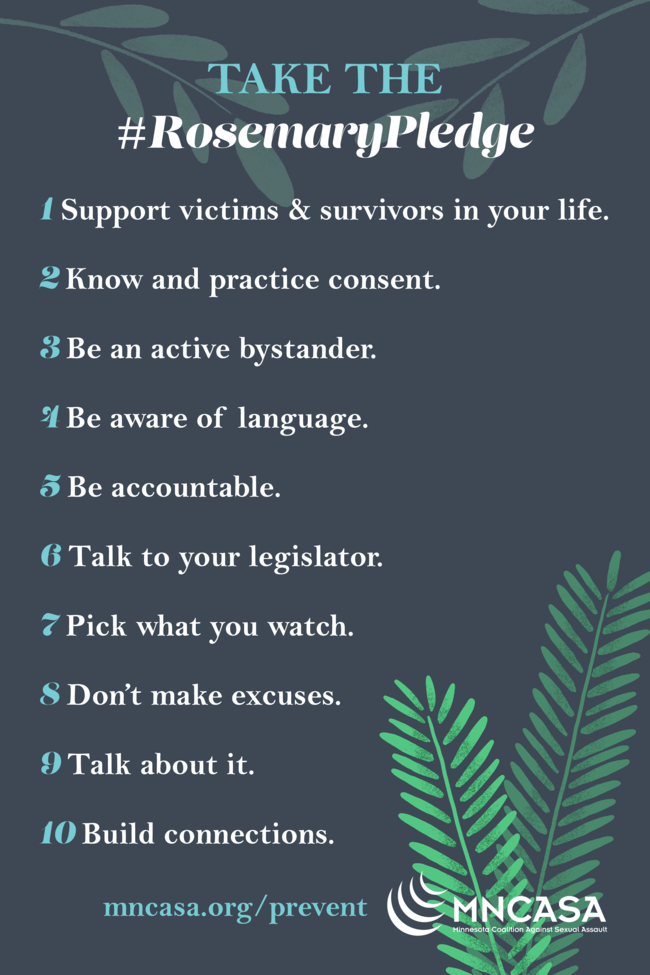Rosemary Project
We can all take steps to make sexual violence prevention possible.
If you want to cultivate change in your community, start small. Watch our Rosemary Pledge videos below for some inspiration. MNCASA also offers 10 simple tips on starting to prevent sexual violence and 5 tips to grow prevention efforts in your community. Finally, take the Rosemary Pledge yourself! All of us contributing small steps will lead to big community change.
Rosemary in ASL
In partnership with ThinkSelf Minnesota, MNCASA is pleased to offer the Rosemary Project videos in American Sign Language (ASL).
What is the Rosemary Project?
Join the sexual violence prevention movement today by taking the Rosemary Pledge. Prevention does not always need to be a huge action or major changes, and the Rosemary Pledge is your agreement to begin taking small, actionable steps towards prevention.
Community-level change is similar to starting a garden. Both can feel overwhelming, confusing, challenging, expensive, and even impossible. For instance, how do you know whether to buy seeds or a potted plant? What tools do you need? Is your soil right? How often do you water it? You might ask similar questions when thinking about sexual violence prevention. Is prevention work already happening in my community, or should I start something? Are there prevention tools available? Is my community ready for making and sustaining change?
Just like a garden, you can start small with prevention. You can grow and nourish one rosemary plant or take one step to prevent sexual violence. MNCASA offers a wide range of tools and resources for sexual violence prevention. Take a look and choose your one small step—your one rosemary plant. Take the Rosemary Pledge telling us what action step you’re going to take to prevent sexual violence below.
Together, we can create communities where everyone can thrive and grow.
Take the Rosemary Pledge to Prevent Violence
10 Simple Steps to Prevent Violence
Chances are you already know at least one victim/survivor, whether you are aware of it or not. The best thing you can do is simply believe someone when they tell you they have seen sexually assaulted. Your role is to listen and provide the support they ask for.
Consent is as simple as getting and giving permission to do something. It is important to get consent before physically interacting with others. You can easily ask someone if it is ok to hug them before just doing so. If they say no, then don’t do it. We can teach the children in our lives that they do not need to hug or kiss others if they do not want to. Using consent gives everyone power over their own bodies and space. Consent Tea is a short video which gives great examples of consent.
Another way you can prevent sexual violence, and other forms of violence, is by being an active bystander. Being an active bystander means you are looking out for those around you and will intervene on situations that look suspicious, uncomfortable, or even potentially unsafe. There are many ways to intervene, NoMore and It’sOnUs offer scenarios with different intervention strategies and bystander tips. Remember it is just as important that you stay safe too. If you are interested in hosting an active bystander training reach out to MNCASA at [email protected].
Jokes and phrases that make light of sexual violence contribute to a culture where sexual harassment, assault, and abuse aren’t taken seriously. What you say matters and sends messages. If you or a friend make a sexist joke those around you who hear it take that as your belief. You can call out this inappropriate behavior by simply saying “that’s not funny.”
We are all going to make mistakes and potentially cause harm at some point in our lives. What matters is we own our actions, recognize when we are wrong or cause harm, genuinely apologize for the mistake, and change our actions moving forward. None of us will be perfect, but we can always strive to do better.
Your voice has power and legislators want to hear from you. If contacting your local legislators is new to you, check out Back to Basics Policy 101 resource package or Meeting with Your Legislators for Beginners (below) to get you started. Remember you also have local community officials who want to hear from you. Other opportunities are to revise policies at your workplace, within schools, and other local establishments. Find out what policies exist around sexual violence in these settings. You can influence change on multiple policy levels!
You can let your money talk when it comes to media. Media is a powerful tool. There are countless movies, T.V. shows, and music videos where sexual violence is portrayed and women are objectified. Choose and fund media that matches your values, sends healthy messages, and doesn’t use gender violence as a lazy plot device. When sexual violence or abusive relationships are portrayed in media, use those scenes to start conversations. Check out the film Miss Representation for more information on harmful media representation.
Within our culture there are harmful norms that create and excuse sexual violence. Gender norms are one example of harmful norms. When we build ideas of what “real men” and “real women” are supposed to be we create strict boxes that are harmful for everyone. The film Tough Guise breaks down harmful messages of masculinity boys and young men receive from culture and media. Another harmful norm in our culture is victim blaming. Sexual violence is never the victim/survivors fault, the only one responsible for sexual violence is the one who caused the harm. Our communities uphold these norms, whether they mean to or not, and we have the power to shift them.
Talking about sexual violence can be hard, but from the discomfort comes culture change. Try having conversation with those you trust and with the children in your life, you can even use this 10 tips resource as a starting point. We cannot prevent sexual violence alone, we need our whole community on board.
Mobilize the people you know to support organizations and events in your community that are working to end sexual harassment, assault, and abuse. Get familiar with your community resources and find your local anti-sexual violence advocacy center here. Then you can team up and take action, like by hosting a lunch and learn on sexual harassment prevention within a workplace. Use your knowledge and connections to make your community a safer and healthier place for everyone who lives there.
Featured Tools & Resources
10 Simple Prevention Steps
Everyone has a role to play in preventing sexual violence within our communities. To cultivate change we all need to play our part. Below are…
5 Sexual Violence Prevention Tips for Communities
Individuals who take steps to prevent sexual violence have a big impact, but a community’s unified efforts can have even greater power to create change.
Ten Simple Prevention Steps for Men
Learn from men who are currently doing prevention work Visit A Call to Men to learn about men in the United…




